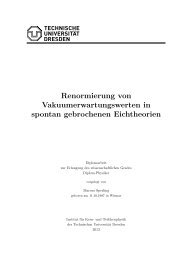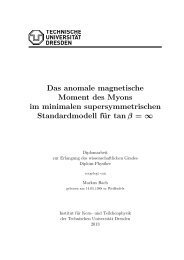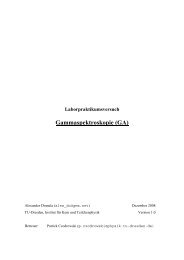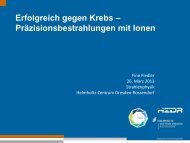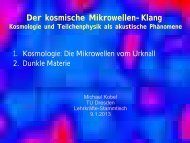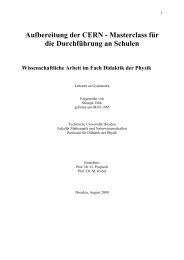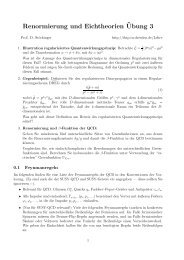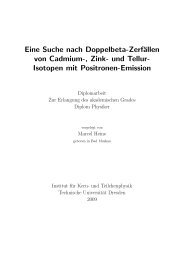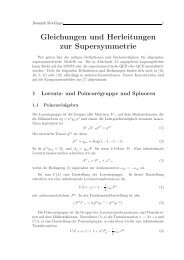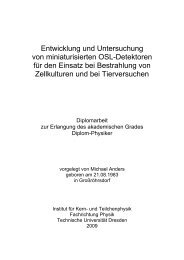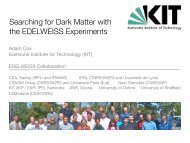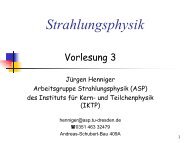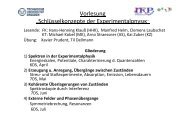a design study for a cobra upgrade to - Institut für Kern- und ...
a design study for a cobra upgrade to - Institut für Kern- und ...
a design study for a cobra upgrade to - Institut für Kern- und ...
Create successful ePaper yourself
Turn your PDF publications into a flip-book with our unique Google optimized e-Paper software.
58 5 Scintilla<strong>to</strong>r <strong>upgrade</strong><br />
back side of the scintilla<strong>to</strong>r layer are favoured by the restricted space<br />
inside the Faraday cage. A readout from only two sides also reduces<br />
the amount of needed readout devices. For such a readout, 12 crystals<br />
of 20×5×5 cm 3 dimensions and 8 cubes of 5×5×5 cm 3 are necessary.<br />
The crystal bars are placed at the right, left, <strong>to</strong>p and bot<strong>to</strong>m side of the<br />
Nest. The readout will be attached <strong>to</strong> the front faces of the crystals. The<br />
front and back side of the Nest will be covered by four cubic crystals<br />
each. The scintillation light of the cubic crystals can be detected from<br />
only one side.<br />
The optimal readout device should provide a good energy resolution<br />
with CsI:Tl crystals, have low radioactive contamination and be compact<br />
in size. Reported resolutions of other experiments using CsI:Tl<br />
crystal with different readout devices help <strong>to</strong> estimate the expected energy<br />
resolution.<br />
However, the listed resolutions in chapter 4.2.3—“Energy resolution”<br />
can give only an orientation <strong>for</strong> these crystal sizes. Especially comparisons<br />
between different readout devices <strong>for</strong> scintilla<strong>to</strong>rs of less than<br />
one cm 3 are not valid <strong>for</strong> crystals of a few h<strong>und</strong>red cm 3 . The limited dimensions<br />
of semiconduc<strong>to</strong>r readout devices in comparison <strong>to</strong> the crystal<br />
surface worsens the energy resolution.<br />
GEANT4 APPLICATIONS CSI<br />
The Geant4 application ”CsI” contains a PhysicsList similar <strong>to</strong> the<br />
previous described ”Scintblock”. An OpticalPhysicsList was introduced<br />
as additional class <strong>for</strong> simulating the scintillation process. It<br />
defines a new particle class, the optical pho<strong>to</strong>n, and new processes,<br />
like the absorption Process (G4OpAbsorption()), Rayleigh scattering<br />
(G4OpRayleigh()), bo<strong>und</strong>ary processes (G4OpBo<strong>und</strong>aryProcess()),<br />
scintillation (G4Scintillation()), Cerenkov radiation (G4Cerenkov())<br />
and wave length shifting (G4OpWLS()). These classes are described<br />
in [48, 49].<br />
A single CsI crystal (5×5×20 cm 3 ) was constructed in a volume filled<br />
with air. It is wrapped in a layer of MgO and attached <strong>to</strong> a readout<br />
device at the two narrow faces of the scintilla<strong>to</strong>r. The readout device is<br />
simulated by a thin glass plate of 0.625 mm and an Al layer of the same<br />
width.<br />
The incident pho<strong>to</strong>ns are initialized outside of the scintilla<strong>to</strong>r material<br />
and hit the crystal surface in the middle between the two readout devices,<br />
perpendicular <strong>to</strong> the surface. The introduced optical pho<strong>to</strong>ns are<br />
produced in the scintillating material after the deposition of energy by



